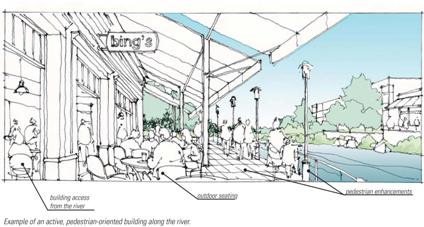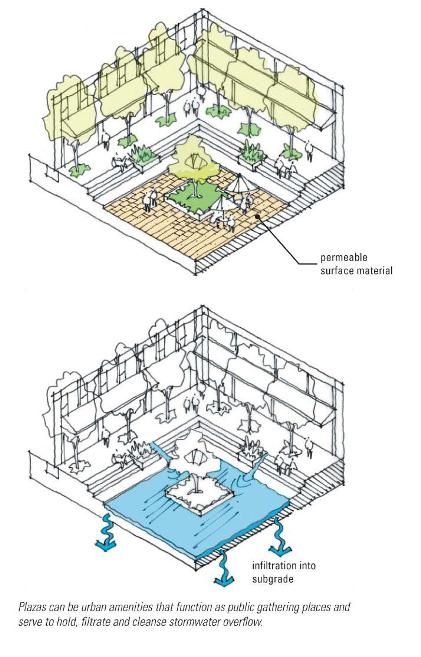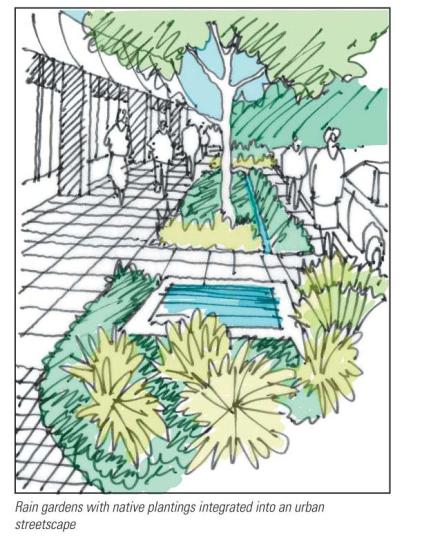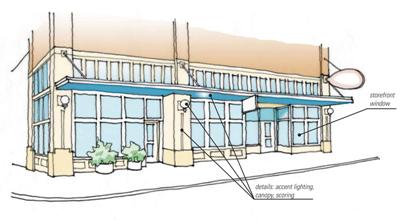Title 17E Environmental Standards
Chapter 17E.060 Shoreline Regulations
Article VIII. Design Standards Specific to Shoreline Districts
Section 17E.060.820 Design Standards Specific to the Downtown District
- Shoreline Relationships – Human Activity.
-
- Purpose.
To recognize that people’s relationship to the river and anticipated uses in each district will inform the design of the built environment. Downtown is an intense urban environment where people and views of the falls create much of the interest in being there. New development along the riverfront that will facilitate desired activities is encouraged. These include shopping, dining, walking, biking, jogging, people watching, viewing the falls, and learning the stories of the river through interpretive displays.
-
- Along the river, new buildings shall provide at least three of the following (R):
-
-
- Outdoor seating or opportunities for outdoor dining.
-
-
- Building entry from the river side.
-
-
- Benches along pedestrian trail.
-
-
- Outdoor balconies.
-
-
- Public plaza with seating.
-
-
- Public viewpoint with interpretive signs (see SMC 17E.060.810(A)(2)(a)(iii), Overlooks and Public Development, and SMC 17E.060.810(A)(2)(b), Overlooks in Private Development).
-
-
- Public art.
-
-
- Opportunities for outdoor vending such as food or bicycle rental.

- Streets, Sidewalks, and Trails – Pedestrian Pathways.
-
- Purpose.
To result in an urban pathway design reflecting the form and intensity of adjacent development, as well as a higher level of pedestrian activity.
-
- Pedestrian pathways shall be at least ten feet wide. (R)
-
- Pedestrian pathways shall be lighted either from nearby buildings or from pedestrian-scaled fixtures. (R)
-
- Seating should be provided at intervals. (C)
- Site Design.
-
- Landscape Character Protection.
-
-
- Purpose.
To ensure that development along the shoreline enhances the natural character of the river and falls including its geologic features and native vegetation.
-
-
- Parking and service areas shall be located so they are screened from views along the shoreline, from opposite shorelines, and from bridges. (R)
-
- Pervious Plazas and Spaces.
-
-
- Purpose.
To create a system of spaces integrated with the ecological systems of the shoreline.
-
-
- Development shall include one or more of the following (R):
-
-
-
- Open spaces.
-
-
-
- Courtyards.
-
-
-
- Plazas.
-
-
-
- Forecourts; or
-
-
-
- Other public spaces that allow for a seamless connection between streets and various uses.
-
-
- Surfacing of these spaces shall allow for the capture of rainwater and filtration into a natural cleansing system of vegetation and sub-grade materials. (R)

-
- Impervious Surfaces.
-
-
- Purpose.
To reduce stormwater runoff rates and volumes, while recognizing that the downtown area will have more intense development and more hard surfaces than other districts.
-
-
- New development shall include at least ten percent pervious surfaces. This may be accomplished by using one or a combination of the following (R):
-
-
-
- At-grade planted areas.
-
-
-
- Permeable paving systems in pedestrian surfaces such as pedestrian walkways or plazas.
-
-
-
- Green roofs.
-
-
-
- Each existing significant tree (over six inches caliper and in good health) protected during design and construction may reduce the total required pervious surface requirement by one percent per tree. The required pervious surface shall not be reduced to less than five percent. For example, an applicant retaining two significant trees shall be required to provide eight percent pervious surfaces; an applicant retaining six significant trees shall be required to provide five percent pervious surfaces. Please note that all landscape requirements shall be met regardless of pervious surface requirements.
-
-
- Stormwater runoff from impervious surfaces shall be directed to treatment or detention areas. For non-pollution generating impervious surfaces (generally this includes most surfaces not traveled on by automobiles) this may include one or a combination of the following as approved by director of engineering services (R):
-
-
-
- Stormwater planters.
-
-
-
- Tree box filters.
-
-
-
- Water features.
-
-
-
- Landscaped areas including swales or rain gardens.
-
-
-
- Cistern for later on-site irrigation.
-
-
-
- Other options as approved by engineering services.

-
-
- Raised curbs are discouraged in parking lots so that stormwater runoff can drain naturally into City approved percolation areas rather than be directed into a concentrated flow. At grade curb alternatives to finished asphalt edges are encouraged. (C)
-
- Planting Palette.
-
-
- Purpose.
To protect, enhance and restore native vegetation along the shorelines, while recognizing the more urban nature of vegetation in the downtown area.
-
-
- It is recognized that within downtown, there will likely be a somewhat more manicured and formal use of plantings to frame buildings, streets and spaces. However, landscape designs that rely upon lawns requiring fertilizers and herbicides, or vegetation that is highly consumptive of water should be avoided. (C)
-
-
- Lawns should be limited to areas where a green walking surface is necessary and desirable, in picnic areas for example. Plants should be chosen for year round interest and grouped according to their water needs for good water efficiency. Drought tolerant species and native plantings are highly encouraged. Native trees, shrubs and groundcover plants should dominate the landscape. (C)
- Building Design.
-
- Character Related to the Setting.
-
-
- Purpose.
To ensure that new buildings are complementary or visually subordinate to the natural splendor of the river and falls, including its geologic features and native vegetation.
-
-
- The dramatic nature of the river and the falls define the image of downtown Spokane in a way unlike any other city. Therefore, new buildings should respect the importance of this magnificent and unique centerpiece by not attempting to compete with it visually. Buildings should be designed with respect to location, form and color, so that the river continues to be the emphasis. (C)
-
-
- Building facades should also incorporate elements that strengthen the natural setting, such as local stone, bay windows, fine-grained articulation, lower floors that frame public spaces, surrounding vegetation. The preference is to have buildings that seem like a built extension of rock, embankments, and outcroppings. (C)
-
- Building Orientation.
-
-
- Purpose.
To ensure that buildings along the shoreline have two public faces – one along the street, the other along the riverfront.
-
-
- While it is expected that buildings will be primarily oriented toward public streets, there shall also be features such as windows, secondary entries, balconies, and public spaces that are oriented to the river. (R)
-
- Ground Floor Animation.
-
-
- Purpose.
To ensure that buildings take advantage of their unique shoreline setting and contribute to the vitality and activity of downtown.
-
-
- The ground floor of buildings shall incorporate a combination of at least three of the following features (R):
-
-
-
- Windows covering more than thirty percent of the ground level façade facing the shoreline.
-
-
-
- Windows covering more than thirty percent of the ground level façade facing the street.
-
-
-
- Masonry or stone covering the ground level façade and producing a “plinth” effect.
-
-
-
- Ground level details such as accent lighting, decorative medallions, and canopies.
-
-
-
- Sculpture, bas relief murals, art worked into paved surfaces.
-
-
-
- Retail uses, such as cafes and restaurants, bike rental, and brew pubs.
-
-
-
- Publicly accessible gardens, courtyards, or plazas.

- Lighting – Dark Sky.
-
- Purpose.
To reduce glare and spillover from lighting associated with parking lots or buildings.
-
- All lighting shall be directed downwards, with cut-off designs that prevent light from being cast horizontally or upward. (R)
Date Passed: Monday, April 19, 2021
Effective Date: Sunday, May 23, 2021
ORD C36034 Section 13
Section 17E.060.820 Design Standards Specific to the Downtown District
- Shoreline Relationships – Human Activity.
-
- Purpose.
To recognize that people’s relationship to the river and anticipated uses in each district will inform the design of the built environment. Downtown is an intense urban environment where people and views of the falls create much of the interest in being there. New development along the riverfront that will facilitate desired activities is encouraged. These include shopping, dining, walking, biking, jogging, people watching, viewing the falls, and learning the stories of the river through interpretive displays.
-
- Along the river, new buildings shall provide at least three of the following (R):
-
-
- Outdoor seating or opportunities for outdoor dining.
-
-
- Building entry from the river side.
-
-
- Benches along pedestrian trail.
-
-
- Outdoor balconies.
-
-
- Public plaza with seating.
-
-
- Public viewpoint with interpretive signs (see SMC 17E.060.810(A)(2)(a)(iii), Overlooks and Public Development, and SMC 17E.060.810(A)(2)(b), Overlooks in Private Development).
-
-
- Public art.
-
-
- Opportunities for outdoor vending such as food or bicycle rental.

- Streets, Sidewalks, and Trails – Pedestrian Pathways.
-
- Purpose.
To result in an urban pathway design reflecting the form and intensity of adjacent development, as well as a higher level of pedestrian activity.
-
- Pedestrian pathways shall be at least ten feet wide. (R)
-
- Pedestrian pathways shall be lighted either from nearby buildings or from pedestrian-scaled fixtures. (R)
-
- Seating should be provided at intervals. (C)
- Site Design.
-
- Landscape Character Protection.
-
-
- Purpose.
To ensure that development along the shoreline enhances the natural character of the river and falls including its geologic features and native vegetation.
-
-
- Parking and service areas shall be located so they are screened from views along the shoreline, from opposite shorelines, and from bridges. (R)
-
- Pervious Plazas and Spaces.
-
-
- Purpose.
To create a system of spaces integrated with the ecological systems of the shoreline.
-
-
- Development shall include one or more of the following (R):
-
-
-
- Open spaces.
-
-
-
- Courtyards.
-
-
-
- Plazas.
-
-
-
- Forecourts; or
-
-
-
- Other public spaces that allow for a seamless connection between streets and various uses.
-
-
- Surfacing of these spaces shall allow for the capture of rainwater and filtration into a natural cleansing system of vegetation and sub-grade materials. (R)

-
- Impervious Surfaces.
-
-
- Purpose.
To reduce stormwater runoff rates and volumes, while recognizing that the downtown area will have more intense development and more hard surfaces than other districts.
-
-
- New development shall include at least ten percent pervious surfaces. This may be accomplished by using one or a combination of the following (R):
-
-
-
- At-grade planted areas.
-
-
-
- Permeable paving systems in pedestrian surfaces such as pedestrian walkways or plazas.
-
-
-
- Green roofs.
-
-
-
- Each existing significant tree (over six inches caliper and in good health) protected during design and construction may reduce the total required pervious surface requirement by one percent per tree. The required pervious surface shall not be reduced to less than five percent. For example, an applicant retaining two significant trees shall be required to provide eight percent pervious surfaces; an applicant retaining six significant trees shall be required to provide five percent pervious surfaces. Please note that all landscape requirements shall be met regardless of pervious surface requirements.
-
-
- Stormwater runoff from impervious surfaces shall be directed to treatment or detention areas. For non-pollution generating impervious surfaces (generally this includes most surfaces not traveled on by automobiles) this may include one or a combination of the following as approved by director of engineering services (R):
-
-
-
- Stormwater planters.
-
-
-
- Tree box filters.
-
-
-
- Water features.
-
-
-
- Landscaped areas including swales or rain gardens.
-
-
-
- Cistern for later on-site irrigation.
-
-
-
- Other options as approved by engineering services.

-
-
- Raised curbs are discouraged in parking lots so that stormwater runoff can drain naturally into City approved percolation areas rather than be directed into a concentrated flow. At grade curb alternatives to finished asphalt edges are encouraged. (C)
-
- Planting Palette.
-
-
- Purpose.
To protect, enhance and restore native vegetation along the shorelines, while recognizing the more urban nature of vegetation in the downtown area.
-
-
- It is recognized that within downtown, there will likely be a somewhat more manicured and formal use of plantings to frame buildings, streets and spaces. However, landscape designs that rely upon lawns requiring fertilizers and herbicides, or vegetation that is highly consumptive of water should be avoided. (C)
-
-
- Lawns should be limited to areas where a green walking surface is necessary and desirable, in picnic areas for example. Plants should be chosen for year round interest and grouped according to their water needs for good water efficiency. Drought tolerant species and native plantings are highly encouraged. Native trees, shrubs and groundcover plants should dominate the landscape. (C)
- Building Design.
-
- Character Related to the Setting.
-
-
- Purpose.
To ensure that new buildings are complementary or visually subordinate to the natural splendor of the river and falls, including its geologic features and native vegetation.
-
-
- The dramatic nature of the river and the falls define the image of downtown Spokane in a way unlike any other city. Therefore, new buildings should respect the importance of this magnificent and unique centerpiece by not attempting to compete with it visually. Buildings should be designed with respect to location, form and color, so that the river continues to be the emphasis. (C)
-
-
- Building facades should also incorporate elements that strengthen the natural setting, such as local stone, bay windows, fine-grained articulation, lower floors that frame public spaces, surrounding vegetation. The preference is to have buildings that seem like a built extension of rock, embankments, and outcroppings. (C)
-
- Building Orientation.
-
-
- Purpose.
To ensure that buildings along the shoreline have two public faces – one along the street, the other along the riverfront.
-
-
- While it is expected that buildings will be primarily oriented toward public streets, there shall also be features such as windows, secondary entries, balconies, and public spaces that are oriented to the river. (R)
-
- Ground Floor Animation.
-
-
- Purpose.
To ensure that buildings take advantage of their unique shoreline setting and contribute to the vitality and activity of downtown.
-
-
- The ground floor of buildings shall incorporate a combination of at least three of the following features (R):
-
-
-
- Windows covering more than thirty percent of the ground level façade facing the shoreline.
-
-
-
- Windows covering more than thirty percent of the ground level façade facing the street.
-
-
-
- Masonry or stone covering the ground level façade and producing a “plinth” effect.
-
-
-
- Ground level details such as accent lighting, decorative medallions, and canopies.
-
-
-
- Sculpture, bas relief murals, art worked into paved surfaces.
-
-
-
- Retail uses, such as cafes and restaurants, bike rental, and brew pubs.
-
-
-
- Publicly accessible gardens, courtyards, or plazas.

- Lighting – Dark Sky.
-
- Purpose.
To reduce glare and spillover from lighting associated with parking lots or buildings.
-
- All lighting shall be directed downwards, with cut-off designs that prevent light from being cast horizontally or upward. (R)
Date Passed: Monday, April 19, 2021
Effective Date: Sunday, May 23, 2021
ORD C36034 Section 13